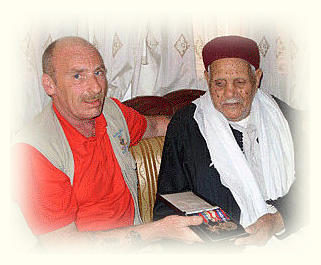
Press Releases
In November 2012, a Libyan shepherd discovered the remains of a WW2 Italian soldier at Got el Elab. South of
Gazala in eastern Libya, Got el Elab formed part of the Gazala Line in May 1942.
for his war service. Western Desert Battlefield Tours was able to obtain replacement medals for Mohamed and
were presented to him by Steve Hamilton on 7th April 2009. As a footnote, Mohamed is the only son of Omar el
Mukhtar the legendary "Lion of the Desert" who fought the Italians for over twenty years before being captured
and executed in 1931.
On October 22nd 2009 and for the first time in 67 years, 91 year old veteran Captain Robert Day (formerly of
the 2nd Armoured Brigade) returned to the battlefields of North Africa. During his week long tour to Egypt
Robert visited the war cemeteries at Alexandria (pictured) El Alamein and Halfaya Sollum. Going out into the
desert and onto the actual battlefield Robert recalled "This is just how I remember it". Roberts journey into the
past was also filmed and recorded for use in the forthcoming "Heroes Return" documentary.
In October 2011 Western Desert Battlefield Tours were proud to escort Veterans of the Desert Rats Association
to El Alamein. On 23 rd October the veterans laid a wreath at the El Alamein War Cemetery in remembrance of
their Fallen comrades. The Duchess of Cornwall who is the Patron of the Desert Rats also sent a wreath to
Honour the Desert Rats, a wreath which the Veterans gladly laid on the Duchess of Cornwall’s behalf.
Having lead battlefield tours to Egypt and Tunisia in January, February and March of 2011, we would like to
assure everyone that Egypt and Tunisia are safe for Battlefield Tours again. We were made most welcome by
people in both countries.
In the last week of May 2008 I discovered a large number of forgotton war graves just east of Tobruk. The
original cemetery stems from the 1930's and contained Italian soldiers killed in clashes with the famous "Lion of
the Desert" Omar el Mukhtar. From a distance the cemetery which is surrounded by a wall appears to be an old
desert fort, and so it must have appeared this way to British and Commonwealth troops when they arrived in the
area in early 1941. Believing that it was an enemy position the Allies shelled the so-called fort. However, from its
location and the amount of destruction it could well have been British warships that did the damage.
You can imagine the damage caused by shelling a cemetery, grave stones and human remains would be
everywhere and so it is today. At some point the Italians remains were re-interred outside the cemetery walls
encased in concrete. Next to these are a large number of what we call "real battlefield graves" that is shallow
graves covered in stones forming a long cairn so often seen in old photographs. These are obviously casualties
stemming from the fighting in 1941 and 42. My years of experience in the desert have taught me not to be too
rash about these finds as often a sand filled foxhole can also resemble a grave, and Arab graves, so often
found, face east and the dead are never placed in a coffin. The decisive moment came when a human skull was
uncovered.
I have informed the Commonwealth War Graves Commission and Italian Military Attache in London, (as there
are known Italian graves there) There are no official Italian war cemeteries in Libya, all the Italian war dead have
been repatriated by the order of the Libyans, this again stems from the Italian invasion of Libya in 1911 and the
Libyan resistance. It is my belief that the "real battlefield graves" may well contain British or Commonweath dead
of the Second World War. They could of course be Italian and buried by the Allies, but the fact remains that there
are now far too many graves on the outside of the original cemetery than could have been inside.
On November 4th 2008, the 66th Anniversary of the ending of the battle of El Alamein, the remains of former
war hero Sgt Eric Pearson MM formerly of the Royal Artillery, Parachute Regiment and SAS, were scattered
along the Ruwesait Ridge/Deir el Shein position south of El Alamein. Sgt Pearson won the Military Medal at the
Deir el Shein while commanding a Troop from 82nd Battery RA, they had been in support of the 18th Indian
Brigade during Rommels first attack on the Alamein postion. His last wish was to be with his mates.
On the 4th April 2009 the remains of former Royal Air Force despatch rider Harry Barnes were scattered over
the battlefield at Sidi Rezegh airfield (south of Tobruk, Libya) on behalf of his widow Pauline. Harry spent most of
the Second World War in North Africa and loved the desert. Harry died in November 2008 and his last wish was
that his ashed be scattered over the desert that he loved so much.
Mohamed Omar el Mukhtar, now 88 years old, was an officer serving with the Libyan Arab Force (Freedom
Army) attached to British and Commonwealth forces during the 1941/42 Siege of Tobruk. After the war he
moved to the old Italian town of Barce, when in 1963 an earthquake destroyed most of the town. Sadly for
Mohamed, during the earthquake he lost his war medals that were awarded to him by the British Goverment




